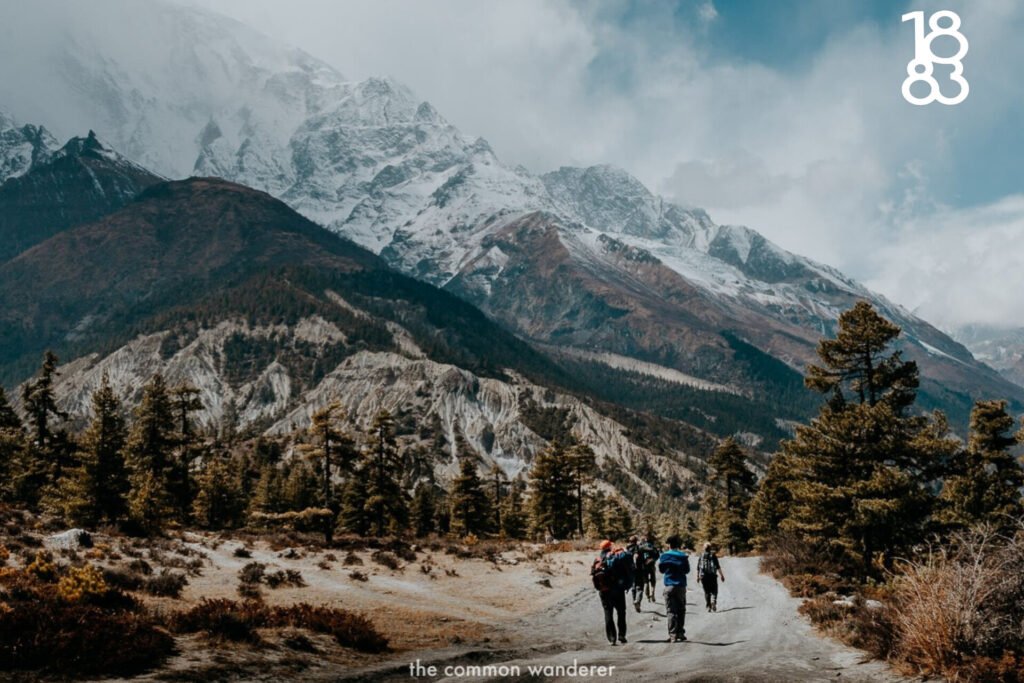Packing for the Annapurna Circuit Trek requires careful consideration to ensure you have all the essentials for a comfortable and safe journey. The trek, which traverses a range of altitudes and diverse environments, demands a mix of practical gear, personal items, and clothing that can handle changing weather conditions.
First and foremost, appropriate clothing is crucial. Layering is the key to adapting to varying temperatures and weather conditions. Start with a moisture-wicking base layer that will keep you dry and comfortable. Insulating layers such as a fleece or down jacket are essential for warmth in the colder regions of the trek. Additionally, a waterproof and windproof outer layer is necessary to protect against rain, snow, and wind. Packing lightweight, quick-drying clothing helps manage sweat and moisture, which is particularly important in high-altitude trekking.
Footwear is another vital consideration. Invest in a good pair of trekking boots that offer ankle support, traction, and protection. Well-worn boots that are broken in before the trek can prevent blisters and discomfort. Alongside trekking boots, pack a pair of comfortable camp shoes or sandals to relax in during the evenings.
Sleeping gear is also important for a comfortable trek. Annapurna Trek A high-quality sleeping bag rated for sub-zero temperatures is essential, as temperatures can drop significantly, especially at higher elevations. Some trekkers choose to bring a sleeping bag liner for added warmth and hygiene. A lightweight sleeping pad is beneficial for cushioning and insulation from the cold ground.
Other essential items include a sturdy daypack to carry your daily necessities, such as water, snacks, and extra clothing. Hydration is crucial, so a durable water bottle or hydration system is necessary. Carrying a portable water purifier or purification tablets can be useful for ensuring safe drinking water along the trail. Trekking poles are highly recommended for stability and to reduce strain on your knees, particularly during steep ascents and descents.
Personal items such as a first aid kit, including blister treatment, pain relievers, and altitude sickness medication, are important for addressing any health issues that arise. Sunscreen, lip balm with SPF, and sunglasses are essential for protection against the sun, especially at higher altitudes where UV exposure increases.
Packing a headlamp or flashlight with extra batteries is crucial for navigating in the dark and during early morning starts. A multi-tool or knife can be handy for various tasks, and a power bank for charging electronic devices is useful given the limited access to electricity on the trek.
Lastly, don’t forget to bring personal hygiene items, such as biodegradable soap, a small towel, and hand sanitizer. It’s also wise to pack some lightweight snacks and energy foods to supplement your diet along the way. By carefully selecting and packing these essentials, you can ensure that you are well-prepared for the Annapurna Circuit Trek, allowing you to focus on enjoying the stunning landscapes and cultural experiences.
Introduction to Packing for the Trek
Packing for the Annapurna Circuit Trek is a crucial part of preparation, ensuring you have the right gear and essentials for a safe and enjoyable journey. This trek, which takes you through diverse landscapes and varying altitudes, demands careful selection of clothing, equipment, and personal items. The goal is to balance packing light with bringing everything needed to handle different weather conditions, manage physical exertion, and ensure comfort. Proper packing not only enhances your trekking experience but also minimizes the risk of injury or discomfort. Understanding what to bring and why helps you navigate the trek more effectively and enjoy the adventure to the fullest.
Essential Clothing Items
Clothing is a critical component of packing for the Annapurna Circuit Trek, given the range of temperatures and weather conditions encountered. Start with moisture-wicking base layers that keep sweat away from your skin, ensuring comfort during vigorous activity. Insulating layers, such as fleece or down jackets, are essential for warmth, especially at higher altitudes where temperatures can plummet. A waterproof and windproof outer shell is crucial for protection against rain, snow, and strong winds. Opt for lightweight, quick-drying materials that can be easily layered to adapt to changing conditions. Don’t forget a hat, gloves, and sun protection, including sunglasses and sunscreen, to safeguard against UV exposure and the elements.
Footwear Considerations
Footwear is vital for the Annapurna Circuit Trek, where a good pair of trekking boots can make a significant difference in comfort and safety. Choose boots that offer sturdy ankle support, good traction, and are well-broken-in to avoid blisters and discomfort. High-quality trekking boots with waterproofing features are beneficial for navigating through varied terrain and wet conditions. In addition to trekking boots, packing a pair of lightweight camp shoes or sandals is advisable for comfort during rest periods and at your accommodation. Properly fitted and functional footwear is essential for managing the challenging terrain and ensuring a more enjoyable trek.
Sleeping Gear and Shelter
Sleeping gear is crucial for a good night’s rest on the Annapurna Circuit Trek, where temperatures can drop significantly, particularly at higher elevations. A high-quality sleeping bag rated for sub-zero temperatures is essential to stay warm and comfortable throughout the trek. Many trekkers also choose to bring a sleeping bag liner for added warmth and hygiene. Alongside the sleeping bag, a lightweight, inflatable sleeping pad provides insulation from the cold ground and adds cushioning for better sleep. While tents are not typically required as most trekkers stay in guesthouses, a compact and durable tent might be useful for those who prefer camping or expect to trek in less accessible areas.
Cooking and Eating Utensils
While most trekkers eat at guesthouses and tea houses along the Annapurna Circuit, having basic cooking and eating utensils can be useful for flexibility and convenience. A compact, lightweight stove and a few cooking pots or pans can be handy for preparing simple meals or boiling water. It’s also practical to pack reusable eating utensils, such as a spork or spoon, and a collapsible cup for drinking. Additionally, consider carrying a small, durable container for storing snacks or leftover food. Although many accommodations provide meals, having your own utensils and cooking gear ensures you can handle any situation where dining options might be limited or if you prefer to cook some of your own food.
Water Purification Options
Access to clean drinking water is essential on the Annapurna Circuit and Tilicho Lake Trek, where natural sources may be contaminated or unreliable. To ensure safe hydration, several water purification options are available. Water filters are a popular choice, effectively removing bacteria, protozoa, and sediments. Portable filters like pump-style or squeeze filters are compact and easy to use. Another option is purification tablets or drops, which are lightweight and convenient for treating water, though they may alter the taste. Boiling water is a reliable method, though it requires a stove and sufficient fuel. It’s wise to carry a combination of these methods for added security, ensuring you can access safe drinking water throughout the trek.
First Aid Kit Essentials
A well-stocked first aid kit is vital for addressing minor injuries and health issues during the Annapurna Circuit Trek. Essentials include adhesive bandages, antiseptic wipes, and gauze for treating cuts and blisters. Pain relievers such as ibuprofen or acetaminophen help manage aches and altitude sickness symptoms. Include blister treatment supplies like blister pads or moleskin, as foot issues are common. Altitude sickness medication, such as Diamox, is crucial for preventing and treating symptoms. A thermometer, tweezers, and scissors are useful for various tasks. Personal medications and any prescription drugs should also be packed. Having a comprehensive first aid kit ensures you are prepared for common ailments and emergencies on the trek.
Trekking Gear: Poles and Backpacks
Trekking poles and backpacks are essential components of your gear for the Annapurna Circuit Trek, contributing to comfort and efficiency. Trekking poles provide stability and reduce strain on your knees, particularly during steep ascents and descents. Adjustable poles with comfortable grips and shock absorption features are ideal. When selecting a backpack, choose one with a capacity of 40 to 60 liters, providing enough space for your gear without being overly bulky. Features like padded shoulder straps, a hip belt, and a hydration reservoir or water bottle pockets enhance comfort and convenience. A well-fitted backpack distributes weight evenly, reducing fatigue and allowing you to carry necessary supplies efficiently.
Navigation Tools: Maps and GPS
Navigating the Annapurna Circuit requires reliable tools to stay on track and ensure safety. Detailed maps of the trekking route are essential for understanding the terrain and planning daily segments. Topographic maps provide valuable information about elevation changes and trail features. A GPS device or smartphone with a GPS app can supplement maps by offering real-time location tracking and navigation assistance. Many trekkers also use trekking apps that include trail maps and GPS functionality. Carrying a compass is a good backup in case of technology failure. Combining traditional maps with modern navigation tools helps ensure you stay oriented and make informed decisions throughout the trek.
Personal Hygiene Items
Maintaining personal hygiene on the Annapurna Circuit is important for comfort and health. Pack biodegradable soap for washing hands and body, as it is environmentally friendly and complies with conservation practices. A small towel or quick-dry cloth is useful for drying off after washing. Include hand sanitizer for times when water is unavailable. Personal hygiene items such as toothpaste, a toothbrush, and a small mirror should also be included. Consider bringing a small toilet paper roll and a trowel for digging a cat hole, as some remote areas may not have toilet facilities. Keeping clean and managing hygiene properly helps maintain comfort and health throughout the trek.
Sun Protection: Sunscreen and Sunglasses
Sun protection is vital on the Annapurna Circuit Trek due to the increased UV exposure at higher altitudes. The sun’s rays are stronger and more intense, making sunscreen an essential item in your packing list. Opt for a broad-spectrum sunscreen with a high SPF (30 or above) to protect against both UVA and UVB rays. Apply it generously and reapply every few hours, especially if you’re sweating or have been in the water. Sunglasses are equally important for shielding your eyes from the harsh glare of the sun. Choose sunglasses with UV protection and a wraparound design to reduce light exposure from the sides. These items help prevent sunburn and protect your skin and eyes from potential damage.
Electronics and Photography Equipment
Electronics and photography equipment are important for capturing memories and staying connected during your Annapurna Circuit Trek. A reliable camera or smartphone with a good camera is essential for documenting the stunning landscapes and cultural experiences. Bring extra batteries and memory cards, as charging opportunities can be limited. For those planning to use electronic devices, consider carrying a portable power bank to keep your devices charged. If you need to stay connected, a satellite phone or a SIM card with data for Nepal can be useful, though network coverage may be sporadic in remote areas. Ensuring your electronics are well-protected in waterproof bags or cases will safeguard them against the elements.
Snacks and Energy Foods
Snacks and energy foods are crucial for maintaining energy levels and stamina during the Annapurna Circuit Trek. High-energy, lightweight snacks such as nuts, dried fruits, granola bars, and chocolate are great options for quick nourishment between meals. Energy gels and electrolyte tablets can also be beneficial for maintaining hydration and boosting energy during strenuous sections of the trek. Packing some comfort foods like trail mix or energy bars provides both sustenance and morale boosts. Having a variety of snacks ensures you can stay fueled throughout the trek and manage any gaps between meals provided by the guesthouses or tea houses.
Documents and Important Papers
Carrying the right documents and important papers is essential for a smooth trekking experience. Ensure you have your passport, trekking permits (Annapurna Conservation Area Permit and TIMS card), and any necessary visas. Make photocopies of these documents and store them separately from the originals in case of loss or theft. Travel insurance documents are also crucial for emergencies. It’s useful to carry a small waterproof pouch to keep these papers safe. Additionally, having a list of emergency contacts and important addresses can be helpful. Organizing and securing these documents ensures you have what you need for a hassle-free and safe trek.
Conclusion: Final Packing Tips
In preparing for the Annapurna Circuit Trek, thoughtful packing ensures you have everything needed for a successful and enjoyable journey. Start by checking your gear and clothing, making sure they are appropriate for varying weather conditions and rugged terrain. Prioritize essential items like sun protection, water purification methods, and personal hygiene supplies to maintain comfort and health throughout the trek. Electronics and photography equipment should be packed with extra batteries and protection against the elements. Don’t forget snacks and energy foods to keep your energy levels up, and ensure all important documents are organized and secure. By following these final packing tips, you can focus on the adventure ahead, knowing you’re well-prepared for the trek.



